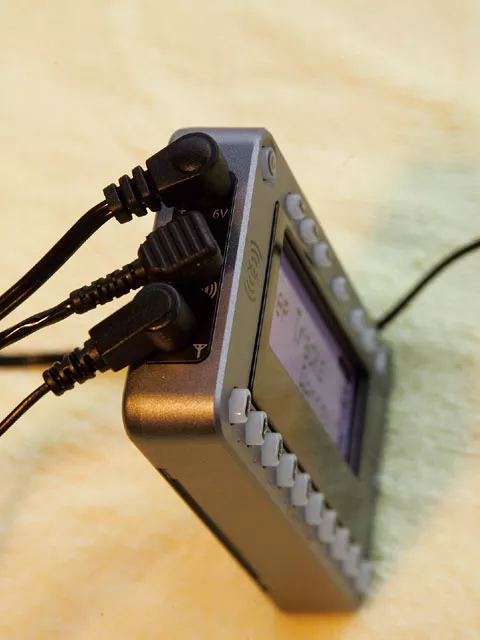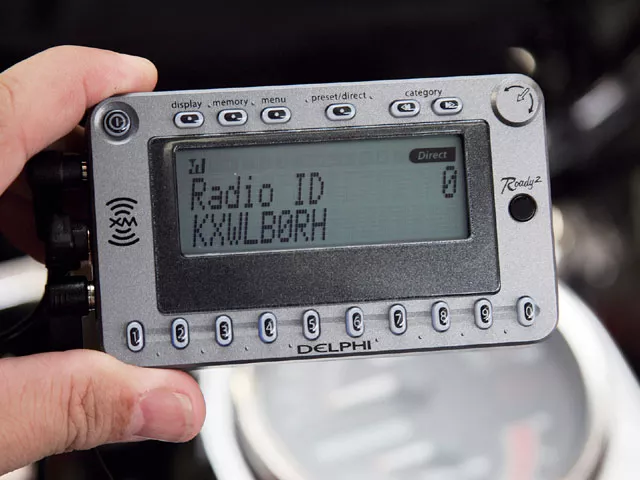XM Satellite Motorcycle Radio

Here is an example of the XM receiver’s display with the artist and radio channel listed.

Connections on the side of the Roady 2 include the antenna, audio output, and 12-volt input.

The magnetic-base antenna mounted neatly on the steel handlebars.

To power the unit, we simply plugged the 12-volt male adapter into the female connector (which we stashed inside our windshield bag).

Instead of playing the Roady 2 through an audio component system, we decided to plug in a pair of custom-fit, Competition Sports Monitors ($175 + S&H;) made by EARinc.

Each XM receiver has its own unique ID number. Tuning to channel 0 shows the number. You will need this number to establish service with XM. After the service has been initiated and the Roady 2 connected, it is very easy to navigate.
If you have been riding a bike for any length of time, you’ve no doubt seen lots of things come and go. Some of them have staying power, while others don’t. Hell, a lot of folks out there think an Evo motor is new technology, so when it comes to new ideas, many of those same folks are skeptical.
With the huge popularity of baggers these days, one thing most people can agree on is that listening to the radio while on a cruise can be quite enjoyable. The motorcycle audio market has run the gamut from AM/FM, cassette, and CD to MP3. Now the latest offering from Harley on some of its ’06 models is radios equipped with XM satellite receivers from the factory. No more will you have to fiddle with the scan button to find nothing but static and electronic noise. Gone are the days of listening to the same CD over and over again, ’til you just can’t take it anymore.
If you haven’t had the pleasure of being in a vehicle with an XM receiver, you just don’t know what you’re missing. Having the ability to tune into any one of 153 stations (as of this printing) is remarkable. It makes no difference what kind of music you are into–rock, country, blues, jazz, hip-hop, world, reggae, or bluegrass–it’s all there. The 153 channels are broken down as follows: 67 commercial-free music channels, 33 sports channels, 18 talk radio channels, 21 metro traffic and weather channels, and, last but not least, two children’s channels.
The beauty of XM is the fact that it doesn’t matter where you are–you get the same crystal-clear reception pretty much everywhere in the country. Just keep in mind that the signal has a hard time penetrating structures such as tunnels, parking structures, and buildings.
Sounds great, but what if you don’t own an ’06 Harley set up to receive XM Radio? (XM comes standard on the ’06 CVO Ultra Glide and as an option on Electra and Ultra models). Well, you can do what we did and get your hands on one of the new Roady 2 XM receivers (MSRP: $49.99). This compact, portable unit is designed to run on 12-volt power, as it supplies input to either an audio component with an auxiliary input jack, powered speakers, or, in our case, a pair of custom stereo earphones from EARinc.
Installation was a simple matter of running a pair of wires from the bike’s battery to a bag mounted on the inside of the windshield. To the end of the wires we connected a female cigarette lighter connector that would provide power to the Roady 2. From there we plugged the satellite antenna into the side of the receiver. The antenna works best when its magnetic base is attached to a minimum 1-foot-square piece of steel. Since this was not possible on our Road King, we simply attached the antenna to the handlebar just behind the brake master cylinder. Our last connection was to plug the earphones into the Roady 2 and fire it up. Considering we would be riding in some wet conditions, we passed on mounting the receiver on the bars and simply dropped it in the bag and zipped it closed.
Once we were on the road, the unit fired right up and gave us a minimum of two bars of signal strength at all times. At first we didn’t think that would cut it, but we were wrong–the thing worked great. No matter where we were, we never lost signal (tunnels notwithstanding). The ear plug-style speakers we used worked very well. EARinc. makes each custom set one at a time, based on a sample of silicone material injected into the wearer’s ears. This step ensures a close, comfortable fit. As the earplugs are manufactured, a set of tiny yet very good-sounding speakers is cast inside of them.
There is a variety of accessories designed to expand the limits of the Roady 2. These include an inexpensive home kit that allows it to be played through a home stereo system, a personal portable system, and a high-end PlayDock designed for those looking for the ultimate audio experience.






